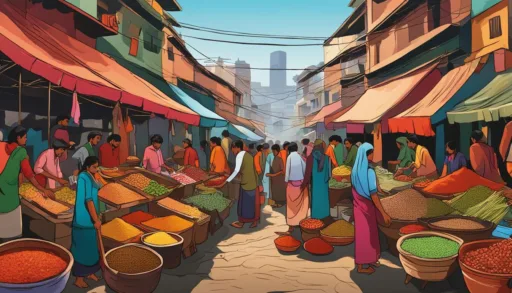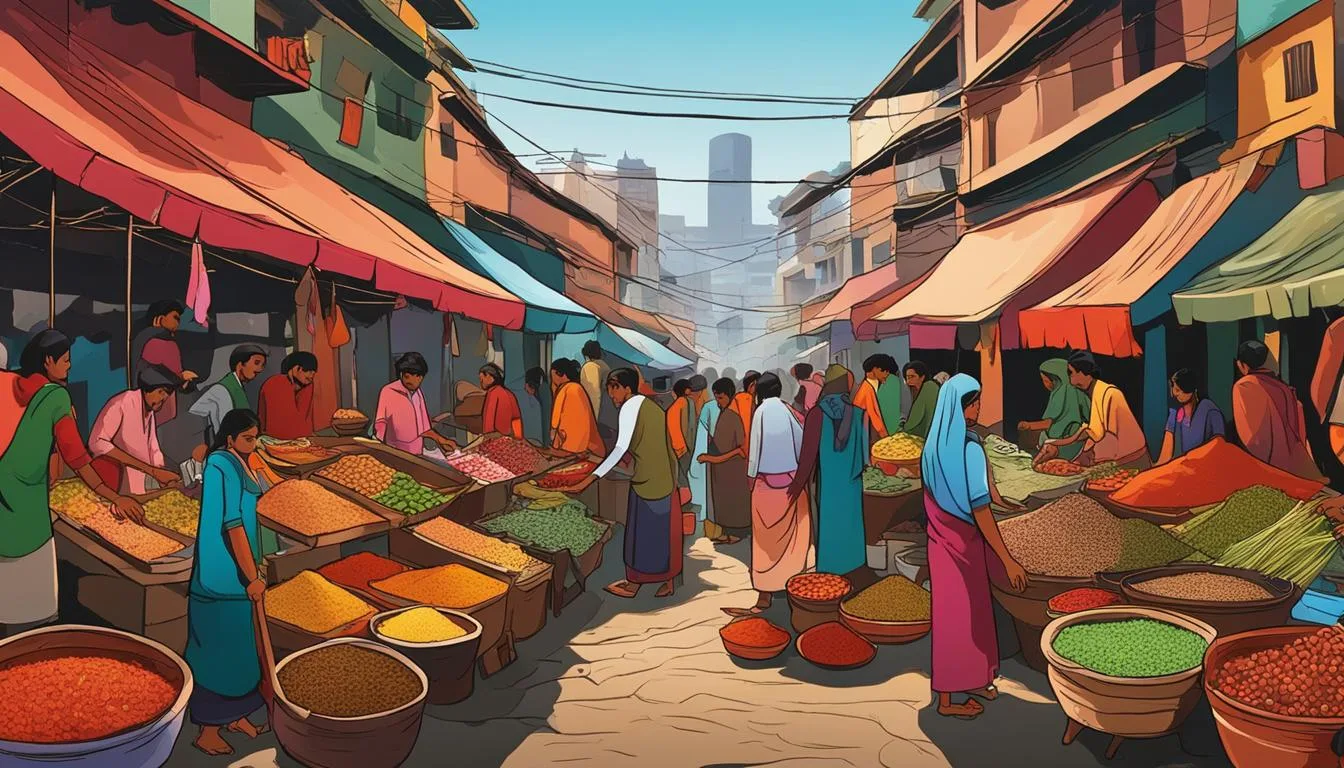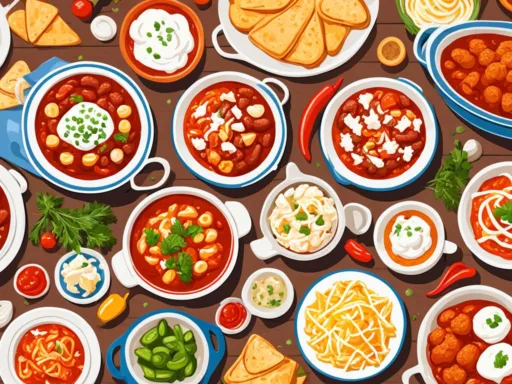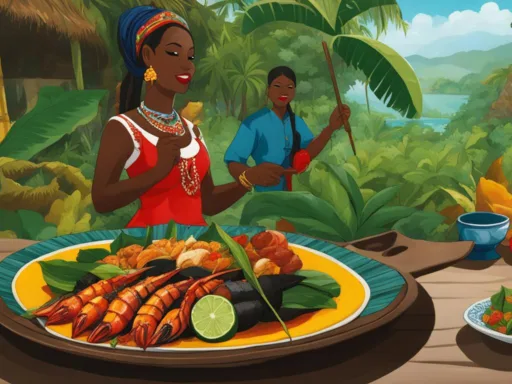Did you know that Bangladesh is known as the “Land of Rivers”? This remarkable geography has cultivated more than just lush landscapes; it has fostered a Bangladeshi cuisine that is as diverse as the waterways that weave through the country. As we begin our Bangladeshi Food Journey, you’ll discover that each traditional Bangladeshi recipe is a voyage into a culture that holds its flavors as heritage. With every mouthful, there’s a story, offering you a genuine Taste of Bangladesh. Beyond just nourishment, these meals are a celebration—deeply rooted in the ethos of families and communities, ready for you to explore Bangladeshi flavors.
Key Takeaways
- Discover how Bangladesh’s unique geography influences its rich culinary landscape.
- Gain insight into the intimate link between traditional Bangladeshi recipes and cultural heritage.
- Understand the social significance of meals in Bangladeshi households.
- Preparing for an immersive Taste of Bangladesh that extends beyond dining.
- Experience the adventure of culinary exploration, as you delve deep into Bangladeshi food culture.
The Rice Melody of Bangladesh
Rice resonates at the heart of food culture in Bangladesh, epitomizing a rich heritage that goes beyond mere sustenance—it is a celebration of life itself. Engrained in every meal, the story of rice in this country is a melody composed of grains, each note defined by the age-old Bengali food traditions and culinary artistry.
Bangladesh’s bountiful deltas yield some of the world’s most coveted rice varieties, each carrying a distinct aroma that is not just nourishing but also entwines with the day-to-day life and festivities of its people. The following sections delve into this integral staple and its preparation, a true testament to the nation’s culinary identity.
The Staple: Aromatic Rice Varieties
A mosaic of rice varieties is cultivated in Bangladesh’s fertile plains, each perfuming the kitchen with its unique scent. Basmati, known for its exquisite fragrance, often plays a starring role in countless authentic Bangladeshi dishes. The grain’s long, slender shape and delicate flavor make it a prized ingredient in the kitchens of Bangladesh, transforming each dish into a culinary masterpiece.
The Preparation: Traditional Rice Dishes
The alchemy of cooking rice in Bangladeshi cuisine is an ancestral craft passed down through generations. Precision in preparation elevates the simple grain to a sublime dining experience. Iconic dishes such as biryani are not just prepared, they are orchestrated—with every grain of rice absorbing the flavors of meticulously marinated meats and fragrant spices.
For a taste of comfort, the ubiquity of bhorta graces the tables, reflecting the simplicity and resourcefulness of the region’s cooking practices. Beyond the everyday meal is the festive pitha, a dish synonymous with celebrations, mirroring the joyous spirit of the people and their deep-rooted penchant for creativity.
Below is a snapshot of some signature rice-based preparations that emphasize the centrality of rice in Bangladesh’s culinary tapestry:
| Dish | Rice Variety Used | Description |
|---|---|---|
| Biryani | Basmati | A luxurious mix of flavored rice and marinated meat, often served during festive occasions. |
| Bhorta | Short-grain rice | Mashed vegetables or fish served with plain rice, a staple for a simple yet fulfilling meal. |
| Pitha | Sticky rice | Sweet or savory cakes, symbolizing celebration and tradition, relished specially during the winter season. |
| Khichuri | Rice and lentils | A comforting porridge-like blend, perfect for rainy days and often considered a meal of solace. |
The art of rice in Bangladesh does more than just feed a nation; it provides insight into a culture where every meal, every grain, tells a story—of harvest, of history, and of home. As we explore further, let us savor the myriad ways in which these grains are transformed into dishes that are at once deeply personal and universally adored.
Bangladeshi Food Journey: Savoring the Spices
Embark on a sensorial odyssey through the culinary delights of Bangladesh, where a mosaic of spices forms the heart of this rich cuisine. A stroll through any Bangladeshi market unfolds as an exposition of vibrant colors and fragrances, indicative of a heritage deeply rooted in spice mastery. Each scoop of cumin, pinch of coriander, dash of turmeric, stick of cinnamon, and pod of cardamom is a narrative of taste, lovingly blended to forge not just meals, but experiences.
Authentic Bangladeshi dishes are an artistic celebration of both the land and its coastal waters. Imagine the coastal kitchens where chefs are painters and spices their palette. Here, the ilish fish curry takes center stage, its lush, buttery components perfectly accentuating the piquancy of mustard and the fervor of freshly ground green chilies.
This tableau of taste is heightened even more on the coast, where the bounty of the Bay of Bengal influences every dish. Below is a guide to the spices and ingredients commonly woven into the fabric of Bangladeshi coastal cuisine:
| Spice/Ingredient | Description | Used in Dishes Like |
|---|---|---|
| Cumin | Earthy, warm and slightly bitter, ground cumin adds depth of flavor. | Ilish Curry, Kofta, Lentil Soup |
| Coriander | A sweet and citrusy note with a floral aroma, used commonly in ground form. | Biriyani, Bhuna, Chutneys |
| Turmeric | Vibrant yellow and mildly aromatic, turmeric imbues dishes with its healthful properties. | Fish Curries, Dal, Vegetable Stir-Fry |
| Cinnamon | Sweet and woody, this spice adds warmth and complexity to dishes. | Meat Curries, Tea, Desserts |
| Cardamom | Intensely aromatic, it brings a sweet-spicy flavor ideal for both savory and sweet dishes. | Rice Pudding, Curries, Sweets |
In Bangladeshi culinary tradition, the intertwining of spices isn’t just about the layering of flavors but also a testament to a culture that celebrates its history with every meal prepared. The harmonious blend of the savory, the sweet, and the aromatic found in these authentic Bangladeshi dishes is a delicious portal to the very soul of Bangladesh.
Biryani: The Epitome of Flavor
The quintessential Biryani not only tantalizes the taste buds but also captures the essence of Authentic Bangladeshi dishes. As a cornerstone among Traditional Bangladeshi recipes, it embodies a rich history and a meticulous culinary art form. Let us unveil the secrets behind this culinary masterpiece.
Ingredients That Create a Masterpiece
Biryani’s magic starts with its ingredients, each an essential strand in the tapestry of its creation. The premium Basmati rice known for its long grains and exceptional aroma provides the perfect foundation for the layers of flavor. Tender cuts of meat, marinated with a special blend of spices such as cinnamon, cardamom, and mace, contribute to its rich taste, complemented by the subtle heat of green chilies and the freshness of mint and coriander leaves.
| Ingredient | Role in Biryani |
|---|---|
| Basmati Rice | The aromatic star lending texture and fragrance |
| Meat (Chicken, Beef, or Lamb) | Provides a succulent, protein-rich layer |
| Yogurt & Spices (Cinnamon, Cardamom) | Forms the flavor-packed marinade |
| Saffron & Rose Water | Imparts a floral, exotic aroma and color |
| Fried Onions | Adds a sweet, caramelized complexity |
| Ghee | Enriches the dish with a nutty, buttery richness |
The Ritual of Cooking Biryani
“Biryani is not just a dish, it is a celebration of aroma, flavor, and tradition” – This adage by renowned chefs illustrates the culinary finesse required to prepare this regal dish.
The cooking process is as much a ritual as it is a recipe. Meticulous marination allows the meat to absorb the intricate spice blend. The rice is parboiled to capture its delicate texture. Layers are thoughtfully arranged, ensuring each grain of rice is coated with flavors, and then, the dish is sealed and slow-cooked to perfection, encapsulating the essence of Bangladeshi gastronomy.
The result is a harmonious interplay of flavors and textures, with the fragrant rice complementing the tender, spiced meat. To experience Biryani is not only to taste an Authentic Bangladeshi dish but to partake in an age-old tradition that continues to be a beloved staple in feasts and family tables across Bangladesh.
Ilish Fish Curry: Bengal’s Beloved
When it comes to Bangladeshi cuisine, the Ilish fish curry stands as a profound emblem of the country’s culinary heritage. The lush, buttery texture of the Ilish, also celebrated as the “King of Fish,” is a testament to the rich aquatic life sustained by the extensive river systems of Bangladesh. This dish is not just a culinary delight but also a narrative of the Bangladeshi people and their bond with the waters that flow through their land. The process of creating this beloved dish involves an amalgamation of traditional practices and local ingredients that echo the authentic Taste of Bangladesh.
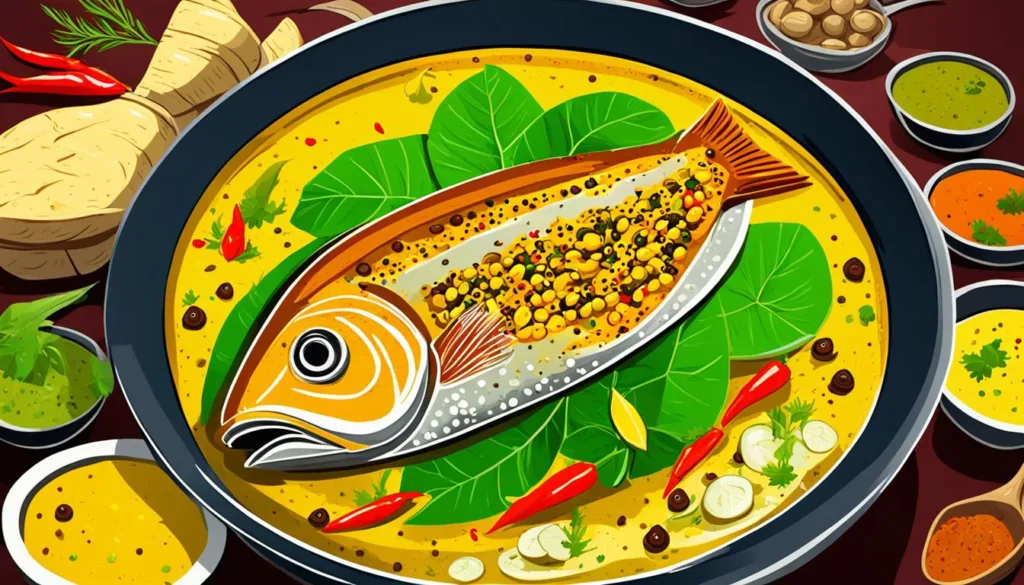
Through each spoonful of Ilish fish curry, one can experience the joy of the people who have long perfected the art of balancing the piquancy of mustard oil with the fiery zest of green chilies. This time-honored recipe is a staple among Traditional Bangladeshi recipes and continues to be a favorite amongst locals and gourmands alike, capturing the essence of Bangladesh’s gastronomic excellence.
- Key ingredient: Ilish fish, known for its tender texture
- Flavor profile: Buttery fish with a piquant kick of mustard
- Cooking technique: Simmering the fish in traditional spices
As a dish enjoyed across different regions of Bangladesh, Ilish fish curry can vary slightly in preparation but maintains a consistent standard of taste and quality. Below is a glimpse into the recipe components that create this Bangladeshi delicacy:
| Ingredient | Role in the Dish | Flavor Contribution |
|---|---|---|
| Ilish fish | Star of the curry | Lush, buttery, rich |
| Mustard oil | Base for curry | Aromatic, pungent, adds depth |
| Green chilies | Spice element | Fresh, spicy kick |
| Turmeric and chili powder | Color and warmth | Earthy, smoky notes |
| Nigella seeds | Flavor enhancer | Subtle, herby tones |
This historical synergy of flavors is more than just food; it’s a legacy passed down through generations, ensuring that the Taste of Bangladesh remains an unforgettable culinary experience – rich, authentic, and eternally cherished.
Exploring Bhorta Varieties
The art of creating Authentic Bangladeshi dishes is vividly depicted through the wide array of Bhortas, which reveal the richness of Bengali food traditions. Bhorta, essentially a mash seasoned with pungent mustards oils, chili, and spices, comfortably sits as a beloved staple in any Bangladeshi household. It manifests the nation’s penchant for integrating nuanced flavors into simple ingredients.
This traditional medley is as diverse as the regions of Bangladesh, each contributing to the spectrum of tastes. Here is a table showcasing some popular Bhorta varieties, including their main ingredients and the unique twist they bring to the dinner table:
| Bhorta Variety | Main Ingredients | Regional Twist |
|---|---|---|
| Begun Bhorta (Eggplant) | Roasted eggplant, onions, green chilies, mustard oil | A smoky flavor with a touch of piquancy |
| Aloo Bhorta (Potato) | Boiled potatoes, fried onions, mustard oil, cilantro | Earthy tones enhanced with a lively zest |
| Tomato Bhorta | Grilled tomatoes, garlic, mustard oil | Charred sweetness balanced with garlicky warmth |
| Sheem Bhorta (Broad Bean) | Boiled broad beans, garlic, green chili, mustard oil | Textured with a blend of sharp spices |
Each bite into these Bhortas is not only an exquisite experience for the palate but also a narrative of the Bangladeshi way of life where cooking is an act of love and tradition. As you delve deeper into the profound simplicity of Bangladesh’s culinary customs, Bhorta stands out as a testament to the joys of minimalist cooking, bolstered by rich, zesty flavors that permeate through every household.
Embracing the Sweetness of Pitha
The cultural fabric of Bangladesh is interwoven with the delectable strands of Traditional Bangladeshi recipes, none more cherished than the sweet delicacy known as Pitha. These rice cakes are a convergence of creativity and tradition, making them a revered element of the Culinary delights of Bangladesh. With forms and flavors as rich and varied as the nation’s heritage, pithas encapsulate the sweet essence of Bangladeshi festivities.
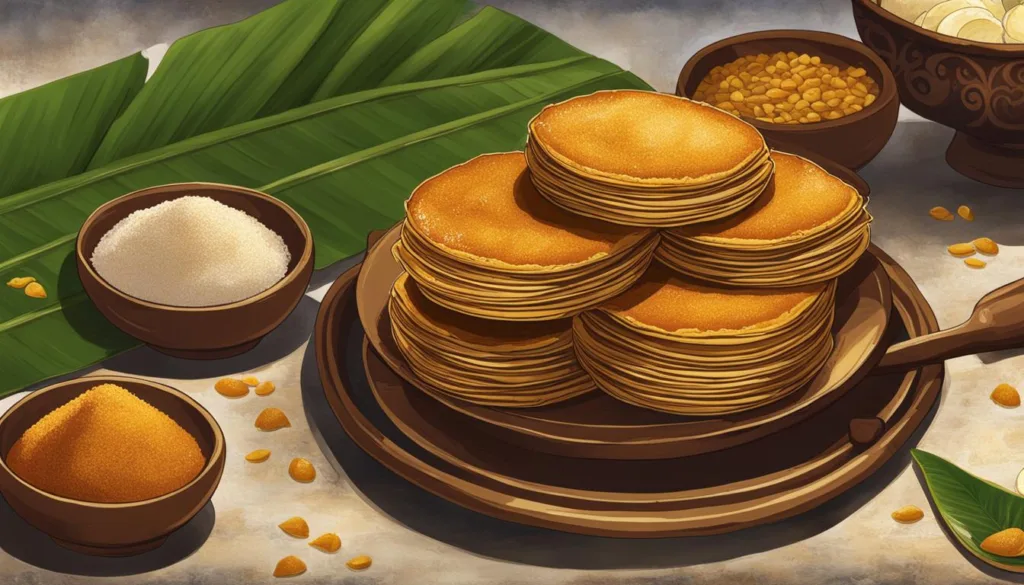
Diversity in Sweetness: Different Types of Pithas
Be it the sweet stuffing of jaggery and coconut or the savory fillings of spiced vegetables, the types of pitha found in Bangladesh are both numerous and delightful. Here’s a glimpse of the variety that graces the Bangladeshi palate:
- Bhapa Pitha: Steamed and stuffed with delectable fillings such as molasses and grated coconut.
- Puli Pitha: Crescent-shaped cakes filled with sweetened coconut or other fillings, forming a delicious treat.
- Patishapta: A roll-like pitha filled with coconut and jaggery, invoking the essence of celebratory sweetness.
- Chitai Pitha: Thin and crêpe-like, made with rice flour and often served with a sprinkle of molasses.
Festive Significance of Pitha in Bangladesh
In Bangladeshi culture, pithas are more than just tantalizing treats; they are festive emblems that mark important celebrations and seasons. With the onset of winter, the traditional art of pitha-making comes to life, embroidering the culinary landscape with their warmth and sweetness. Let’s honor the festive importance of these beloved rice cakes:
| Festival | Pitha Varieties | Cultural Significance |
|---|---|---|
| Pohela Boishakh | Nakshi Pitha, Chitai Pitha | Celebrating the Bengali New Year with intricate designs of Nakshi Pitha showcases prosperity and artistry. |
| Nabanna | Bhapa Pitha, Puli Pitha | Harvest festival is made special with freshly made, steamed pithas symbolizing gratitude and abundance. |
| Winter Season | Dudh Puli, Patishapta | Winters in Bangladesh are sweetened with stuffed pithas, reflecting the comfort and joy of the season. |
| Weddings and Celebrations | Pakon Pitha, Rosh Pitha | A display of culinary finesse and festivity, these pithas are a staple for any celebration. |
These edible jewels, deeply rooted in the heritage of Bangladeshi festivals, continue to sweeten the communal bond with every bite. As such, pithas do more than satisfy cravings—they are the bearers of stories, the keepers of traditions, and the heart of many a festive occasion.
Authentic Bangladeshi Street Food
As you explore Bangladeshi flavors, there’s nothing quite like the symphony of tastes and scents that emanate from Bangladeshi street food. With every corner turned, you’re greeted with a visual feast of color and a sensorial overload that promises an unforgettable culinary adventure.
Take, for instance, the legendary Fuchka stalls where the crispiness of the hollow dough balls bursts in your mouth with tamarind water, tingling all your taste senses. Or consider the iconic Jhalmuri, a dish bringing puffed rice together with mustard oil, diced onions, chilies, and spices—delivered in a cone of newspaper, it’s the embodiment of the local zest that captures the essence of vibrant urban life.
If there’s one thing that fellow food enthusiasts will agree on, it’s that the streets are the best places to explore Bangladeshi flavors. Not only do they offer a plethora of dishes to sate any craving, but they also provide a glimpse into the daily life and culture of the nation. Here’s a snapshot of what you might find:
- **Kebabs:** Succulent meat grilled to perfection over open flames, the smoke mingling with the spices to tell tales of ancestral recipes.
- **Samosas:** Triangular pastries filled with spiced potatoes, vegetables, or even meat, fried till the exterior carries a satisfying crunch.
- **Bhelpuri:** A tangy mix of puffed rice, sev, tomatoes, potatoes, and a tangy tamarind sauce, throwing a party for your palate.
It’s in this way that Bangladeshi street food does more than just feed the masses; it stitches together a rich cultural tapestry, one where each dish is a narrative of community, tradition, and the everyday hustle-bustle that courses through the nation’s veins. So, whether you’re a local or just passing through, remember that each bite not only fuels the body but also feeds the soul.
Traditional Bengali Sweets: Beyond Rosogolla
When it comes to the culinary delights of Bangladesh, the story sweeps beyond the familiar Rosogolla, diving deep into an assortment of traditional Bengali sweets. Each confection is not just a dessert; it’s a vibrant thread in the fabric of traditional Bangladeshi recipes, woven with love and shared with joy.
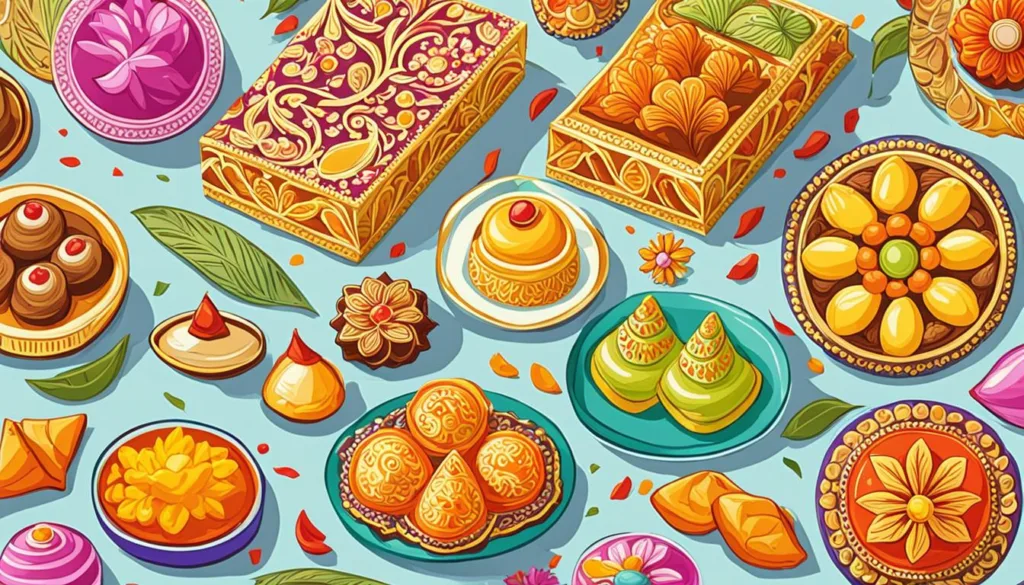
Desserts like the divine sandesh, made of refined milk and sugar, artfully mixed and molded into delicate shapes, and the myriad versions of spongy milk balls drenched in fragrant syrup, each tell a tale of festive moments and daily indulgence. Here, we chart some of the lesser-known yet equally cherished sweets that grace the Bangladeshi palate.
| Sweet Treat | Main Ingredients | Occasion | Flavor Profile |
|---|---|---|---|
| Mishti Doi | Caramelized sugar, milk | Festive celebrations | Sweet, rich, creamy |
| Chomchom | Flour, cream, sugar, saffron | Weddings, New Year | Sweet, sticky, saffron-flavored |
| Kalo Jam | Milk solids, sugar syrup, rose water | Festivals, special events | Dense, sweet, hints of rose |
| Patishapta | Rice flour, coconut, jaggery | Poush Sankranti | Sweet, nutty, warm |
Each of these sweets serves as a warm invitation to immerse oneself in the richness of Bangladeshi desserts, where every bite is a testament to the meticulous craftsmanship of local confectioners. Whether it is the creamy decadence of Mishti Doi or the saffron-kissed layers of Chomchom, these desserts embody the spirit of hospitality and celebration inherent to the culture.
No treat is too small or too simple in the realm of Bangladeshi sweets, as even the smallest mithai shop on the bustling streets is a treasure trove of gustatory delights, ready to tell its illustrious story through flavors that linger lovingly on the tongue.
The Cultural Tapestry of Bangladeshi Cuisine
At the heart of Food culture in Bangladesh is a canvas stitched with vibrant threads of flavors, traditions, and communal bonds. Within every authentic Bangladeshi dish lies a story, each recipe a cherished narrative passed down through generations. It’s a world where every meal is a celebration, encapsulating the country’s history, values, and culinary identity.
Family Gatherings and the Role of Food
In the midst of bustling kitchens and clinking cutlery, Bangladeshi households come together in a symphony of tastes and affection. Family gatherings are where Bengali food traditions are more than customs—they are experiences that sculpt relationships and memories. The communal platter of steamed rice, the shared bowl of lentil dal, and the thali filled with assorted bhortas are not merely dishes; they signify unity and a warm embrace of kinship.
Festivals and Food: A Culinary Celebration
Festivities in Bangladesh dance to the beat of shared feasts, where food is the centerpiece of jubilation. Whether it’s the fasting month of Ramadan culminating in the feasts of Eid-ul-Fitr, or the Bengali New Year, known as Pohela Boishakh, each festival is heightened with an abundance of authentic Bangladeshi dishes. Sweetmeats like rasgulla and sandesh echo the laughter and joy, while steaming plates of biryani symbolize the grandeur of these celebrations. In these moments, every morsel consumed is an ode to the grand culinary heritage of the nation.
Fishing and Aquaculture: Backbone of Bengali Culinary Practices
The lifeblood of Bengali food traditions courses through the myriad rivers of Bangladesh, where fishing and aquaculture are not just economic activities but the essence of a cultural legacy. The silver scales of the Hilsha (Ilish) fish glinting in the marketplace is indeed the Taste of Bangladesh, symbolizing a synergy between nature’s generosity and human culinary artistry.

Below is a glimpse into how fishing touches everyday life in Bangladesh, from local diets to festal cuisines:
- Freshwater Fishing: Bangladesh’s extensive freshwater ecosystems are a thriving hub for native fish species, sustaining both communities and culinary creations.
- Seasonal Delicacies: The arrival of different fish species with changing seasons introduces a rotating menu of fresh, seasonal dishes, vital to regional diets and cultural rituals.
- Aquaculture Advances: Developing aquaculture techniques ensure sustainable fish populations and a consistent supply for local and national consumption.
Tradition meets innovation in Bangladesh’s modern aquaculture:
- Traditional “gher” systems coexist with advanced fish farming techniques to maintain ecological balance and ensure the survival of both culture and biodiversity.
- Community-led initiatives protect local fisheries and fishing techniques, preserving the integrity of Bangladeshi food heritage.
- Education and technology empower fish farmers to maximize yield while minimizing environmental impact.
Here’s a comparative look at the role of fish in the day-to-day and festal Bengali cuisine:
| Daily Diet | Festivals and Celebrations |
|---|---|
| Machher Jhol (Fish curry) | Panta Ilish – Fermented rice with fried Hilsa |
| Smoked Hilsha | Ilish Polao – Fragrant rice cooked with Hilsa fish |
| Fried and steamed fish varieties | Specialty fish dishes with aromatic spices and herbs |
The spirit of Bangladesh’s aquatic abundance is chronicled on every plate, in every household, and in the jubilant feasts held across this verdant land. Fishing and aquaculture remain a testament to the historical, economic, and gustatory narratives of Bangladesh, reaffirming the profound influence of riverine life on the culinary map of this proud nation.
Colonial Influence and Mughlai Legacy in Bangladeshi Cuisine
As culinary journeys around the world unfurl the tapestry of global gastronomy, one cannot overlook the profound impact of the centuries-old Mughlai legacy on Bangladeshi cuisine. These culinary marvels, with their origins steeped in the regal heritage of past empires, now occupy an esteemed place in the hearts and feasts of Bangladeshis. To explore Bangladeshi flavors is to delve into a history where every bite speaks of lavish traditions and cultured palates.
Rich Flavors from a Regal Past
The Mughals, renowned for their rich and aromatic cookery, have left an indelible mark on the country’s culinary practices. Infused with an array of spices, and combined with sophisticated cooking techniques, traditional Bangladeshi recipes have been transformed into opulent dishes that narrate tales of royal banquets and sumptuous feasts.
Occasional Delicacies and Mughlai Offerings
While everyday Bangladeshi meals favor lightness and nourishment, occasions and celebrations call for the grandeur of Mughlai influences. The exceptional flavors emitted from dishes like Kacchi Biryani and Murog Musallam are perfect reflections of the luxurious past from which they were born, offering not just sustenance, but an experience of historical magnificence.
| Dish | Ingredients | Occasion |
|---|---|---|
| Kacchi Biryani | Basmati rice, goat meat, yogurt, saffron | Weddings, Eid |
| Lamb Roast | Lamb, nutmeg, yogurt, cardamom | Large family gatherings |
| Murog Musallam | Whole chicken, ghee, nuts, mace | Celebratory events |
This royal cuisine, though reserved for special occasions, continues to be a symbolic representation of Bangladesh’s rich, cultural lineage and presents a unique aspect of the nation’s culinary journeys around the world. As food connoisseurs explore Bangladeshi flavors, they uncover a chapter of history that is as delectable as it is dignified.
Conclusion
Embarking on a Bangladeshi Food Journey is akin to navigating a river of rich traditions, where every bend brings forth a new culinary discovery. With each Authentic Bangladeshi dish, we uncover a page from the grand narrative that is the Food culture in Bangladesh. From the gently spiced, golden grains of aromatic rice to the celebratory hues of the pithas, every flavor you encounter is a thread in the intricate tapestry of this nation’s epicurean history.
The rhythm of Bangladeshi life is mirrored within its bustling markets and the kitchen hearths of homes where recipes are sanctuaries of communal heritage. Shared meals become reflections of fellowship, and festive banquets turn into an exhibition of lavish hospitality. The diverse food landscapes, from the humble street-side vendor to the sumptuous Mughlai feast, are rich with stories waiting to be savored.
As we conclude our journey, we embrace the fact that when you taste Authentic Bangladeshi dishes, you are engaging with more than just your palate. It’s an exploration into a culinary ethos marked by unity, tradition, and a heartfelt welcome. Whether you are at the start or somewhere in the middle of your own food voyage, remember that in Bangladesh, every meal is an invitation to experience life’s flavor and the spirit of a culture shared generously across generations.
FAQ
What makes Bangladeshi cuisine unique?
Bangladeshi cuisine stands out for its extensive use of spices, aromatic rice, lush coastal ingredients, and the amalgamation of Mughlai influences with traditional Bengali cooking methods. Dishes like biryani and ilish fish curry showcase the country’s rich culinary culture.
What are some must-try traditional Bangladeshi dishes?
Some iconic dishes include biryani, a spiced rice and meat dish; ilish fish curry, made from the national fish hilsa; bhortas, which are mashed vegetable dishes; and a variety of pithas, or rice cakes, that offer a taste of the country’s varied flavors.
What role does rice play in Bangladeshi cuisine?
Rice is a staple in Bangladesh. It’s used in everyday meals as well as in special dishes like biryani. Aromatic rice varieties such as Basmati are cultivated in the fertile river plains and are central to the Bangladeshi food experience.
How are spices used in Bangladeshi cooking?
Spices are integral to Bangladeshi cooking, used to create rich and nuanced flavors. Common spices include cumin, coriander, turmeric, mustard, cinnamon, and cardamom, which are often ground into custom blends that form the basis of many Bangladeshi curries and dishes.
What is the significance of fish in Bangladeshi cuisine?
With a deep riverine culture, Bangladesh prides itself on a variety of fish-based dishes. The ilish fish, deemed the “King of Fish,” is particularly significant and used in dishes like the beloved ilish fish curry.
Where can I experience authentic Bangladeshi street food?
Bangladeshi street food can be enjoyed in the bustling markets and streets of its cities, where vendors sell a range of local snacks like kebabs, samosas, and chaats, offering an authentic taste of the nation’s diverse culinary landscape.
Can you describe the types of bhortas available in Bangladesh?
Bhortas can be made from various ingredients, such as eggplant (begun bhorta), potatoes (aloo bhorta), tomatoes, and even dried fish. They are typically seasoned with mustard oil, onions, garlic, and chilies, making them a flavorful and comforting dish.
What is the cultural importance of pithas?
Pithas hold a special place in Bangladeshi culture, particularly during festivities and celebrations. They come in sweet and savory varieties, often enjoyed during the winter season and times of celebration like Pohela Boishakh, the Bengali New Year.
Are there any special culinary traditions associated with Bangladeshi festivals?
Yes, festivals such as Eid-ul-Fitr and Pohela Boishakh feature special menus with lavish dishes like biryani, korma, and an array of sweets including Pithas and semai. These meals are a significant part of the communal celebration.
What Mughlai influences can be seen in Bangladeshi cuisine?
Mughlai influences in Bangladeshi cuisine are seen through rich and decadent dishes like Kacchi Biryani, Murog Musallam, and various types of Kebabs, which display the lavish use of aromatic spices, dried fruits, nuts, and dairy products.
How does the geography of Bangladesh influence its food culture?
Bangladesh’s geography, characterized by its rivers and fertile plains, is conducive to rice and fish cultivation, defining its food culture deeply. The abundance of freshwater fish and the quality of rice crops influence both daily meals and celebratory dishes.
